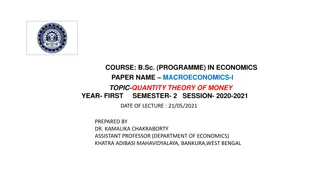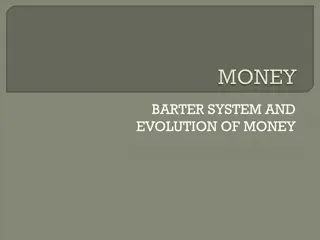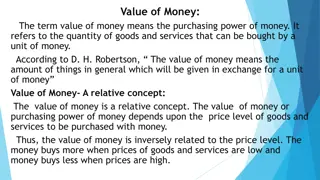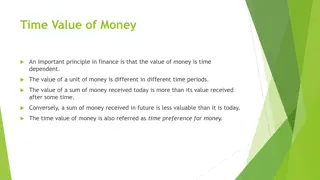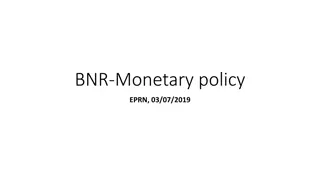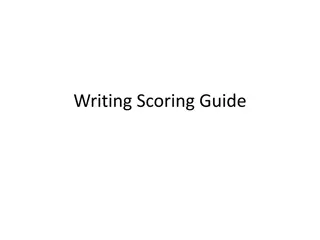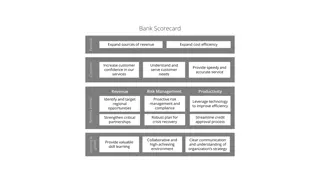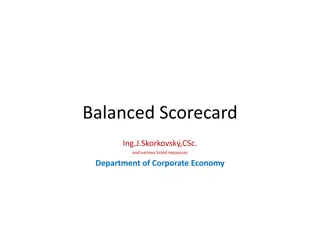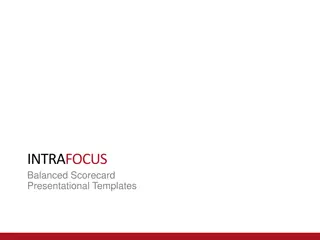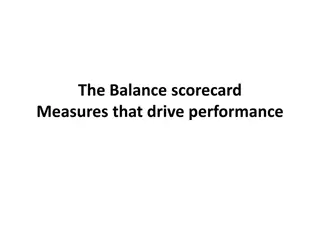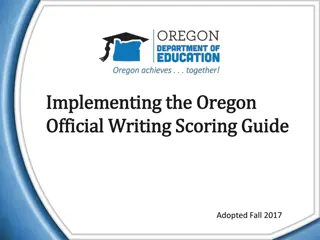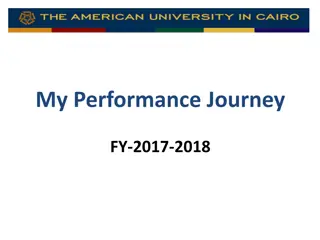Value for Money Scorecard Criteria and Scoring Framework
This content outlines the Value for Money (VfM) scorecard criteria and approach to scoring projects based on six components: Relevance, Effectiveness, Efficiency, Sustainability, Economy, and Cost-Effectiveness, and Equity. Each component is ranked on a scale from 1 to 5, with a project offering excellent VfM likely to have low cost, efficient delivery, strong outcomes, and relevant design. The scoring criteria for each component are detailed to provide a comprehensive understanding of how VfM is evaluated.
Uploaded on Sep 28, 2024 | 0 Views
Download Presentation

Please find below an Image/Link to download the presentation.
The content on the website is provided AS IS for your information and personal use only. It may not be sold, licensed, or shared on other websites without obtaining consent from the author.If you encounter any issues during the download, it is possible that the publisher has removed the file from their server.
You are allowed to download the files provided on this website for personal or commercial use, subject to the condition that they are used lawfully. All files are the property of their respective owners.
The content on the website is provided AS IS for your information and personal use only. It may not be sold, licensed, or shared on other websites without obtaining consent from the author.
E N D
Presentation Transcript
Value for Money Scorecard Criteria
Approach to scoring projects on Value for Money (VfM) To undertake the scoring for the project scorecards, a rubric was developed to provide an overall rating based on the VfM framework. The VfM framework and scorecard is based on six components: 1. Relevance 2. Effectiveness 3. Efficiency 4. Sustainability 5. Economy and Cost-Effectiveness 6. Equity Each of the components are ranked on a scale from 1 to 5 (1 = poor and 5 = excellent). For each project, each of the above components is given an individual score, and an average of the six scores is taken to achieve an overall score out of 5. To put this into context, a project offering excellent VfM is likely to have a low-cost base, have been efficiently delivered with minimal wastage and good timeliness and management processes, be able to evidence strong outcomes and sustainability, with a relevant design which met the needs identified for marginalised girls. 2 | Value for Money Scorecard Criteria
Definition for each VfM component and scoring criteria: Component Definition and scoring This component refers to the degree to which activities meet the needs identified upfront and whether adequate resources have been allocated to them. It also reviews relevance to the donor landscape - i.e., whether the activities are complementary to existing programmes, avoiding duplication and substitution. A score of 4 or 5 means that activities had strong designs that directly addressed barriers and met needs and were complementary within the donor landscape and would not have taken place in the counterfactual scenario. A middle score of 3 means that activities were satisfactory with some barriers addressed. 1. Relevance This sub-component of effectiveness looks at whether the key learning and transition logframe outcomes were achieved. A score of 4 to 5 means the project s logframe targets were exceeded or met, 3 means the targets are on track/partially met, and a score of 2 to 1 means the targets were not met. 2.Effectiveness a) Contribution to outcome- level indicators of learning and/or transition This sub-component of effectiveness looks at whether the logframe intermediate outcomes were achieved. A score of 4 to 5 means the targets were met, 3 means the targets are on track/partially met, and a score of 2 to 1 means the targets were not met. b) Contributions to inter- mediate outcome indicators This component is trying to answer the question: How well are resources being used? It looks at the extent to which the intervention has reached the intended beneficiaries and delivered in an economic and timely manner. A score of 4 or 5 reflects highly efficient processes, good adaptative management, responsive to GEC and FCDO, no wastage of funds and largely on time and on budget. A middle score of 3 reflects some of those characteristics. A low score of 1 or 2 reflects significant inefficiencies. 3. Efficiency This component looks at whether the outcome-level indicator of sustainability was achieved at the girl, community, school and/or system level. A score of 4 to 5 means the targets were met, 3 means the targets are on track/partially met, and finally a score of 2 to 1 means the targets were not met. 4. Sustainability This component looks at the annual cost per beneficiary and compares it with that of other programmes and/or government benchmarks to see if it is in line with what would be expected. It also looks at ways in which resources were optimised throughout the implementation, such as economies of scale (if possible) to induce savings. A score of 4 or 5 means that costs were extremely low relative to benchmarks, with evidence of economies of scale, comparative advantage, cost efficiencies. A score of 3 means costs were reasonable, and that of 1 or 2 means that costs were high compared to benchmarks. 5. Economy and cost- effectiveness This component relates to the degree of marginalisation of the target beneficiaries, based on gender, poverty, ethnicity, rurality, caste/class, disability, conflict, parenting, as well as the degree to which they had been excluded from the education system (i.e., in school vs out of school and for how many years). A score of 4 or 5 reflects ultra marginalised girls, out of school, in extreme poverty, with other marginalising characteristics such as disability or ethnicity. A middle score of 3 reflects girls in school, potentially at risk of dropping out and with a poverty status. A score of 1 or 2 reflects much less marginalisation. 6. Equity 3 | Value for Money Scorecard Criteria
Example Scorecard Criterion Relevance Effectiveness Efficiency Sustainability Economy and Cost-Effectiveness Equity Overall VfM Score Score out of 5 4 4 4 5 4 5 4 (average of all scores) Quite good learning results. Effective pedagogy. EdTech devices not effective, teacher quality good, but training not so effective. Awareness raising very effective. Safer learning environments was effective. Good community support and SEL activities. Maintained consistent attendance. Strong efficiency in operations, use of materials and on time, on budget. Responsive to feedback, well- coordinated with minimal support from FM. Change in management was good. Most marginalised, rural regions poor in Interior Sindh with little economic infrastructure. Out- of-school children that have no access to education opportunities. Justification Effective ALP activities, very relevant. Need- based community and psychosocial support also helped in ensuring 100% of girls graduated to post-primary education. Good systems level agreements with Sindh government with potential for replication. The project has secured more funding from a range of donors and government for the community-based centres for out of schoolgirls. Cost effective, with cost per beneficiary at 115, compares well to government spend. Very relevant in targeting the most marginalised out of schoolgirls. Learning progress since last year, highly effective at keeping girls in school. Activity costs comparable to government. EdTech and teacher training expensive. Clear transition path sustainability. Government annual expenditure per secondary school child: 227 Strength of evidence: Strong Leverage ratio 0.9 Improvements needed at the community level. Good transition and girl level sustainability. 4 | Value for Money Scorecard Criteria
Data used for Scorecard assessments Assessments for each Scorecard criterion should be based on some or all sources of the data already collected within the GEC. This includes: 1. Project-level, midline and endline evaluation data 2. Project monitoring data (undertaken by the project routinely) 3. Analyses of project-level budget/expenditure 4. Activity-based budgets for each project All the available data should be triangulated and weighed up using critical and expert judgement by an objective VfM adviser and the Fund Manager advisers who work closely with the project. This process allows for balanced inferences to be made with a combination of different types of evidence, extending the usefulness of all types of data. 5 | Value for Money Scorecard Criteria





